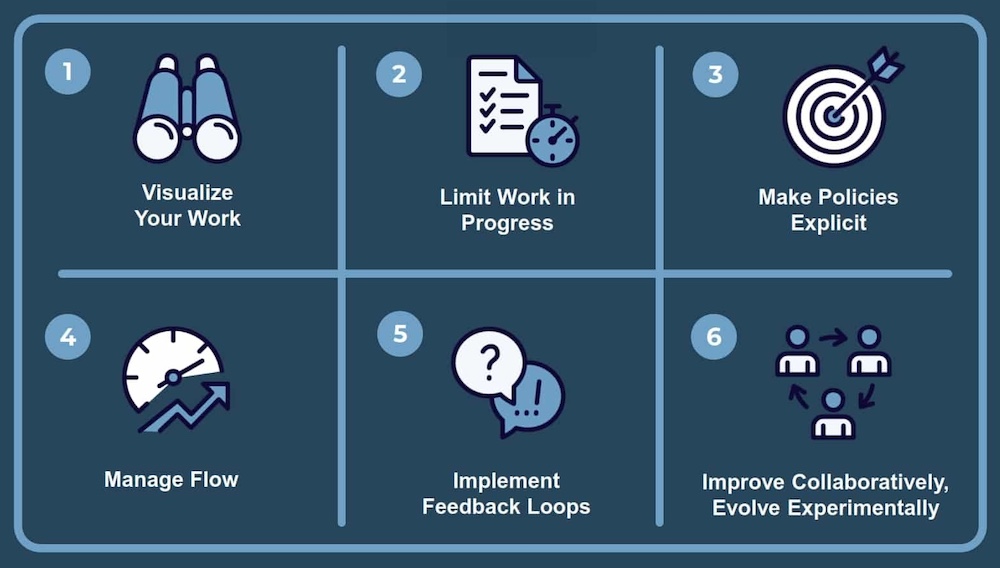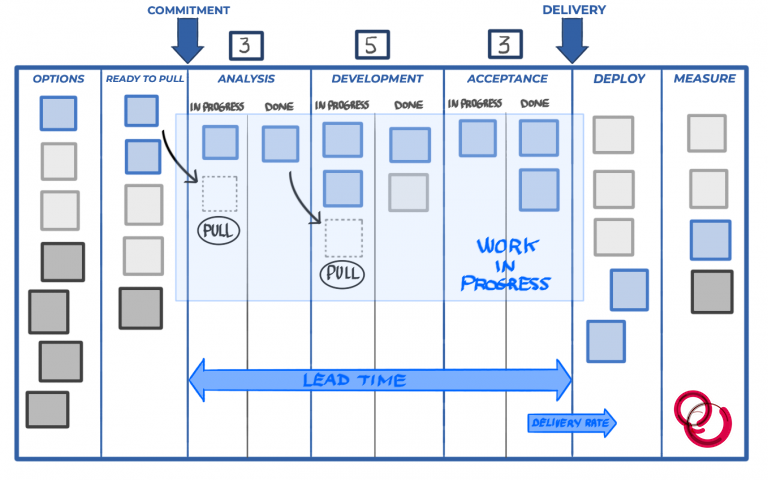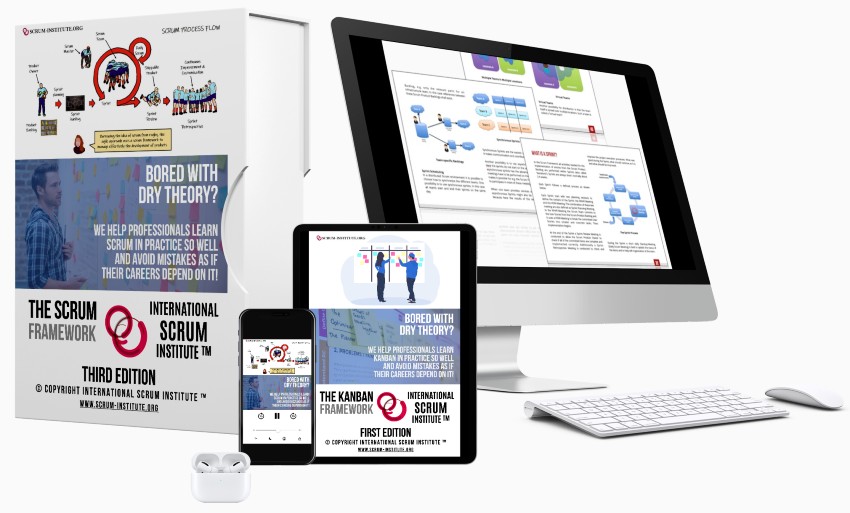Kanban Policies: Explicit Kanban Policies for Agile Implementation and Kanban Policy Examples
The application of Kanban policies involves setting clear rules and conditions that shape the flow of work. You will see this in the form of set limits, selection protocols, and prioritization norms being put to work within a team's workflow. Now, picture a rule that designates how many tasks a team member can have "in progress" at once - that's your Kanban policy in action. Remember, the methods may be simple, but their effects on streamlining tasks and enhancing productivity can be profound. So let's dive into the meat of it.
An example of an explicit Kanban policy could be limiting the number of tasks that can be in progress at any given time to maintain a steady workflow, ensuring that team members can focus on high-priority tasks and avoid overloading themselves.
The goal of explicit Kanban policies is to induce certainty and increase team performance and effectiveness.
A Certified Kanban Project Manager is not interested in the Kanban team being busy. The intention and ambition of a project manager, including a Kanban project manager, are for the Kanban team to be occupied with the proper activities, done correctly, and on-time to generate the expected business outcomes.
A Kanban board makes processes and policies explicit. By viewing the Kanban board, the Kanban team and their stakeholders can build a proper understanding of how their Kanban workflow works and the status of Work In Progress (WIP) work.
Declaring Kanban policies explicitly clears the Kanban team's mind. Explicit Kanban policies should reflect what is important. They define which tasks the Kanban team can willingly ignore,so that they can focus on essential activities. What trade-offs in cost, speed, and quality, the Kanban team is ready to allow and under what conditions.
 Kanban Policies
Kanban Policies
The Nature of Kanban Policies
Kanban, as a framework for agile development and project management, heavily relies on the establishment and adherence to explicit policies governing the flow of work. These policies serve as the bedrock of the entire Kanban system, quietly guiding and directing how work is processed and progressed through various stages, ensuring seamless operations with an eye toward increasing efficiency and reducing bottlenecks.
Consider a team in a software development company using Kanban to manage their project tasks, each progressing through stages such as "To Do," "In Progress," and "Done." From setting limits on how many tasks can be in progress simultaneously to dictating which team members are responsible for selecting and working on particular tasks, these policies are fundamentally important.
Their influence reaches far beyond just creating rules; they are essential in ensuring that work items move through the workflow efficiently and with clarity. By establishing clear rules for work item selection and prioritization, these policies lay down the tracks upon which your project progresses smoothly.
Another crucial aspect of Kanban policies involves setting limits, regulating the maximum number of work items that can exist within a specific stage of the workflow at any given time. These limits prevent overloading and congestion, ensuring smooth movement while highlighting inefficiencies early on.
For instance, a marketing team using Kanban to handle their campaign projects might set a limit of 5 for the "Design" stage, maintaining focus and avoiding spreading themselves too thin across multiple tasks.
By enshrining explicit criteria for work prioritization within these policies, Kanban ensures that everyone involved stays aligned with overarching project goals, preventing confusion about what takes precedence.
In essence, understanding the nature and role of Kanban policies within your workflow is critical to embracing agile methodologies effectively. But now comes the pivotal question: how do you establish these policies in a manner that maximizes their impact in your organization? Let’s explore this further.
Formulating Your Team's Kanban Policies
Establishing effective Kanban policies is foundational in maintaining a smooth workflow and driving agility. First things first, it is essential to understand how the work moves through your team. When you have a clear picture of this, it becomes easier to identify areas that may be slowing your team down or causing inefficiencies. Visualizing the movement of work from the start to finish can reveal bottlenecks, dependencies, and potential areas for improvement.
Imagine your team's workflow as a river. At the surface, it may look calm and steady, but beneath it, there might be rocks that obstruct the flow. By understanding your workflow, you can identify these "rocks" and find ways to remove them. This understanding will guide you in formulating policies that enhance the flow of work, making your teams more productive.
Defining Work-in-Progress (WIP) Limits
Once you have a clear view of your workflow, it's time to set some boundaries. Work-in-progress (WIP) limits are like guardrails on a road; they help prevent overloading and keep things moving smoothly. If there are too many tasks being worked on at the same time, it becomes difficult to focus and complete them efficiently.
Think of it like cooking in a small kitchen with limited counter space. If you try to cook multiple dishes simultaneously without enough prep space, things get messy, and it becomes challenging to cook anything well. Setting WIP limits ensures that everyone focuses on a manageable number of tasks at any given time, fostering a steady pace without overburdening individuals or the team as a whole.
Establishing Entry Criteria
It's important to determine which tasks should enter each stage of your workflow. This is about ensuring that only work meeting specific criteria advances from one stage to another. Defining entry criteria prevents unsuitable tasks from entering stages where they may not be well-suited or ready to proceed.
Consider this like boarding an airplane: passengers must meet certain requirements before they are allowed onto the plane. Similarly, by establishing entry criteria for each stage, you ensure that work items don't progress until they are truly prepared for the next phase of development.
Creating Exit Criteria
Just as entry criteria are crucial, exit criteria are equally important. This part involves setting conditions that must be met for work items to move from one stage to another while maintaining quality and efficiency throughout the workflow.
Picture a coach evaluating players before substituting them into a game. The coach sets specific standards that need to be met before a player can enter the field. Similarly, creating exit criteria ensures that work items meet predefined standards before transitioning to the next stage, thereby maintaining the quality and ensuring seamless progression within your team’s workflow.
With an in-depth understanding of your team's work processes and the formulation of these defined Kanban policies, you'll ensure an optimized workflow that enhances productivity and efficiency.
In orchestrating Kanban policies for efficient workflows, we've tackled fundamental principles that define agile implementation. Now, let's shift our focus to real-world scenarios where these principles come alive.
20 Real-World Kanban Policy Examples
Here are 20 examples of explicit Kanban policies in various different policy categories:
- Familiarity with Work Flow Policy:
Make the Kanban team members familiar with the flow of work.
- Definition of Done (DoD) Policy:
Create Definition of Done's (DoD) with their associated quality assurance checks at both macro (workflow) and micro (workflow steps) levels.
- Backlog Management Policy:
Define how to handle the backlog, specifying who can add items and who can prioritize them.
- Stakeholder Requirements Policy:
Establish a policy on how to handle new requirements from stakeholders.
- Scope Creep Policy:
Define a policy on how to handle scope creep during the course of the project.
- Impediment Resolution Policy:
Establish guidelines on how to handle impediments and situations when Kanban team members are blocked from doing their work.
- Defect Resolution Policy:
Define a policy on how to handle defects from work delivered in the past.
- WIP Limit Policy:
Enforce a WIP (Work in Progress) limit of 3 tasks per team member to maintain focus and avoid multitasking.
- Pull System Policy:
Work items are pulled into the next stage only when there's capacity, ensuring a steady and efficient flow of tasks.
- Expedite Lane Policy:
Use the expedite lane only for critical tasks with explicit approval from the product owner or stakeholder.
- Blocked Task Policy:
If a task is blocked for more than one day, escalate the issue and seek resolution to keep the flow uninterrupted.
- Daily Standup Policy:
Hold a daily standup meeting to discuss progress, impediments, and any adjustments needed in the Kanban board.
- Definition of Done Policy:
Clearly define and communicate the 'Definition of Done' for each stage to ensure consistent quality and completeness.
- Swarm Policy:
Encourage team members to swarm and collaborate on a blocked or high-priority task to expedite resolution.
- Replenishment Meeting Policy:
Conduct a weekly replenishment meeting to prioritize and add new tasks to the backlog based on team capacity.
- Exit Criteria Policy:
Establish exit criteria for each stage to ensure tasks meet specific requirements before moving to the next phase.
- Customer Feedback Loop Policy:
Integrate regular customer feedback loops to gather insights and adapt the Kanban process for continuous improvement.
- Excessive WIP Policy:
Implement a policy to identify and address situations of excessive WIP (Work in Progress) that may hinder the flow, and take corrective actions.
- Cycle Time Tracking Policy:
Establish a policy to consistently track and analyze cycle times for different stages in the workflow to identify areas for improvement and optimize efficiency.
- Continuous Improvement Policy:
Encourage a culture of continuous improvement by implementing a policy that promotes regular retrospectives to reflect on processes, identify bottlenecks, and suggest improvements.
 Kanban Policies Examples
Kanban Policies Examples
Let's take a closer look at how Kanban is applied in various real-world settings. Different industries have unique workflows, and Kanban policies can be tailored to suit their specific requirements. Here are some examples to illustrate the diversity:
Development Teams
In software development, specific policies like code review before merging, work-in-progress (WIP) limits for coding tasks, and setting clear acceptance criteria for user stories are commonly employed. These policies ensure high code quality, efficient task completion, and streamlined workflow management.
Manufacturing Facilities
Kanban principles are widely adopted in manufacturing environments where the movement of materials between workstations needs to be meticulously regulated. Kanban policies help in managing consumption rates, performing quality checks at predefined stages, and balancing inventory levels effectively. This ensures smooth operations with minimal waste and prevents overproduction.
Healthcare Institutions
In healthcare, Kanban policies are instrumental in managing patient care activities. By implementing Kanban systems, healthcare facilities can set limits on pending lab test results, which helps in avoiding backlogs and ensures timely diagnosis and treatment. Furthermore, prioritizing treatment based on patient conditions is another crucial aspect facilitated by Kanban methodologies in healthcare institutions.
The adaptability of Kanban policies across vastly different sectors emphasizes its versatility and practicality. These examples demonstrate how the fundamental principles of Kanban can be customized to meet the specific needs and challenges faced by different industries. By efficiently managing resources, regulating workflow, and prioritizing tasks based on demand, organizations can enhance their operational efficiency significantly.
These real-world instances of Kanban policy implementations underscore the universal applicability of the framework.
Imagine a busy emergency room in a hospital: doctors need prompt access to lab test results for making critical decisions about patient care. By setting clear Kanban policies that enforce limits on pending lab tests and prioritize urgent cases, the medical staff can ensure that patient care is organized systematically without unnecessary delays.
The flexibility of Kanban allows each industry to devise unique approaches that cater to their distinctive operational demands while upholding core principles such as visualizing workflow, setting WIP limits, and promoting continuous improvement.
With these diverse examples in mind, it's evident that Kanban policies offer immense value in addressing intricate operational challenges across varied sectors.
Strategy for Effective Kanban Policy Implementation
Implementing Kanban policies successfully is all about setting up a structure that makes it easy for teams to follow—and ensures they actually want to.
Team Engagement: One of the key aspects of ensuring these policies work is involving your team members in the process. This entails working with them to decide what kind of policies would be best for your workplace. When employees take part in this process, they feel they have ownership over the policies, and are far more likely to stick by them. They're also more likely to offer suggestions that might make the policies better.
Team engagement doesn't just mean workers saying yes or no to policies; it's about ongoing involvement. This journey really becomes about mutual trust and constant improvement.
Continuous Improvement: Regularly updating and refining your Kanban policies is key to ensuring they stay useful and up-to-date. It's not enough to set a policy and leave it there forever. You need to review your policies from time to time based on feedback from your team members and by looking at how well—or not well—your project is doing based on the current policies you've set up.
For instance, if you have a policy that lets a certain amount of tasks occupy one stage of your Kanban board at any one time, but you see those tasks getting stuck, it could be an indication that either your policy isn't right or isn't being followed properly. A policy should change as your business grows and gets better at what it does, so this means taking out what hasn’t worked and maybe adding something new that could work better.
Training and Education: Providing your team with proper resources to help them understand and follow these policies is equally important. This means providing workshops or literature (or access to a good, clear resource), so everyone clearly understands how your Kanban system works. This helps minimize confusion and ensures everyone can cooperate towards a common goal - because everyone knows exactly what they should be doing.
By focusing on team engagement, continuous improvement, and proper training and education, you set up an environment where Kanban policies not only exist but thrive. With these strategies in place, effective implementation of Kanban policies becomes an achievable reality which results in optimized workflow performance and improved project outcomes.
With a robust foundation in establishing effective Kanban policies, let's now explore the fundamental principles that shape their design.
Key Principles for Designing Kanban Policies
Designing effective Kanban policies hinges upon pivotal principles. Let's delve into the first one:
Visual Transparency
Visual transparency is crucial in creating effective Kanban policies. The policies and rules should be visible to everyone involved in the process, ensuring clarity and understanding across the team. This supports transparency and accountability, eliminating hidden or ambiguous guidelines. Visual indicators, such as boards, charts, or digital tools, can clearly display the policies, making them accessible to all team members.
Think of it this way: just like road signs ensure safe and organized driving by communicating speed limits and directions, visualizing Kanban policies ensures a smooth flow of work by clearly communicating rules and expectations.
Flexibility
While providing structure, Kanban policies should allow for flexibility to adapt to varying work scenarios and changing priorities. This principle emphasizes the need for policies to be adaptable and responsive to changes in the workflow. In essence, they function as guardrails rather than rigid constraints, guiding the team while allowing room for creativity and agility.
Flexibility is like a safety net—it keeps things in order without being overly restrictive, enabling the team to navigate unexpected changes with ease.
Data-Driven Decision Making
Another key principle in designing Kanban policies centers around data-driven decision making. This involves basing policies on data and evidence, utilizing performance metrics and analytics to drive continuous improvement. It's imperative to gather relevant data to substantiate policy decisions and continuously evaluate performance against predefined metrics. This way, the policies are rooted in real-world insights rather than assumptions or mere guesswork.
Imagine steering a ship through rough waters using a navigational system that constantly provides real-time feedback about the ship's position and speed. Similarly, a Kanban policy based on data-driven decision making acts as a guiding system, allowing teams to make informed adjustments based on real-time performance feedback.
These principles form the bedrock of effective Kanban policy design, ensuring transparency, adaptability, and evidence-based decision-making as key ingredients in creating policies that truly support agile implementation.
 Make Kanban Policies Explicit
Make Kanban Policies Explicit
The Importance of Explicit and Binding Kanban Policies
When it comes to implementing Kanban, having policies that are both explicit and binding is crucial. These policies provide clear guidelines that help teams manage their workflow effectively and consistently. By explicitly defining the rules and making them binding, ambiguity is reduced, and predictability is increased in the flow of work.
Think of these policies as the unbreakable rules of engagement within your team. They set the boundaries for how work should be managed and moved through the system. Just like a well-regulated traffic system ensures smooth movement on the roads, explicit and binding Kanban policies ensure a smooth flow of work through your organization.
Clarity in Decision-Making
When specific conditions are established within the workflow, team members can make informed decisions about their tasks. For example, if a policy states that a maximum of three items can be in progress at any given time, it reduces the chance of overloading team members and helps them prioritize their work effectively.
Without clear policies, chaos can ensue. Imagine trying to drive on a road with no road signs or traffic lights – it would likely result in confusion and disorder. Similarly, without explicit policies, teams may struggle to understand how work should be managed, leading to inefficiencies and frequent interruptions.
Ensuring Work Quality
Explicit policies also contribute to maintaining the quality of work. Imagine a restaurant with no set food safety standards or no specified recipe for its dishes; it would lead to inconsistent quality and potential health hazards. Similarly, binding Kanban policies enforce certain standards for completing and delivering work items, ensuring consistency and enabling the maintenance of a high-quality output.
Moreover, having clear parameters regarding when work moves from one stage to another allows teams to focus on refining each task to meet predefined criteria before progression. This enhances work quality and reduces the likelihood of defects.
Enhanced Overall Efficiency
By establishing explicit and binding Kanban policies, teams can enhance their overall efficiency. The clarity provided by these rules enables team members to understand their responsibilities better and allows managers to monitor performance more effectively.
This leads to enhanced trust within the team as everyone knows what is expected of them and they can hold each other accountable for sticking to the defined policies. Furthermore, management can identify areas for improvement more easily when deviations from established norms occur.
In conclusion, investing in well-defined Kanban policies is an investment in establishing clarity, ensuring work quality, enhancing efficiency, promoting accountability, and ultimately achieving success in managing workflows.
What are some of the ideas for making process policies visible?
Answer: Ensure visibility by using a physical Kanban board with distinct columns and cards. Utilize digital tools like project management software for real-time display of process policies. Enhance visual cues, such as color-coded cards, within the Kanban system to highlight specific process policies.
Are there any common mistakes or pitfalls to avoid when defining explicit Kanban policies?
Answer: Yes, there are common mistakes and pitfalls to avoid when defining explicit Kanban policies. One mistake is setting too many strict policies that can hinder flexibility and adaptability. Another mistake is not involving the team in the policy definition process, which can lead to resistance and lack of buy-in. According to a survey conducted by Agile Alliance, teams that involved their members in defining policies reported higher levels of satisfaction and productivity.
Can you provide some real-world case studies showcasing successful Kanban policy implementation?
Answer: Absolutely! In our free of charge Kanban book, "The Kanban Framework", Kanban Policies: Explicit Examples for Agile Implementation, I include several real-world case studies that demonstrate successful Kanban policy implementation. One such case study is Microsoft Corporation, which increased its productivity by 30% within six months of adopting Kanban. Another example is Amazon Global, which reduced lead time by 50% through the implementation of Kanban policies. These case studies highlight the effectiveness of Kanban in improving workflow and achieving tangible results.
How can explicit Kanban policies help improve team collaboration and communication?
Answer: Explicit Kanban policies can greatly enhance team collaboration and communication by providing clear guidelines and expectations for how work should flow within a team. With explicit policies, team members have a shared understanding of how work is prioritized, assigned, and completed, reducing ambiguity and improving coordination. This helps in minimizing misunderstandings, delays, and conflicts among team members. A study conducted by the Project Management Institute found that teams using explicit Kanban policies reported a 30% increase in collaboration and a 25% improvement in communication within their projects.
What are the benefits of implementing explicit Kanban policies in a project?
Answer: Implementing explicit Kanban policies in a project offers several benefits. Firstly, it provides clarity and transparency by clearly defining workflow stages, work-in-progress limits, and rules for moving tasks. This fosters better communication and collaboration among team members. Secondly, explicit policies help in identifying bottlenecks and waste, allowing for continuous improvement. Finally, studies have shown that organizations using explicit Kanban policies experience higher productivity, reduced lead times, and improved quality, resulting in a competitive advantage (Source: "Kanban in Action" by Marcus Hammarberg and Joakim Sundén).
What resources or tools are available to assist in creating effective and clear Kanban policies?
Answer: In "Kanban Policies: Explicit Examples for Agile Implementation," several resources and tools are suggested to aid in creating effective and clear Kanban policies. Firstly, online Kanban board software such as Trello or Monday offer visually appealing and user-friendly interfaces for managing tasks and workflows. Additionally, books like "Kanban in Action" by Marcus Hammarberg provide practical insights and real-world examples to guide policy creation. Finally, attending workshops or training sessions conducted by Kanban experts can offer invaluable hands-on experience and knowledge transfer. A survey conducted among Kanban practitioners showed that 87% found using online Kanban boards helpful, while 63% reported improved policy clarity after training sessions.
 Explicit Kanban Policies with Examples
Explicit Kanban Policies with Examples
Takeaway for Explicit Kanban Policies
In this article, we delved into the realm of Explicit Kanban Policies, uncovering a plethora of insights to enhance your understanding and implementation of this agile methodology. The multifaceted approach outlined here offers valuable takeaways for both novices and seasoned practitioners.
- Process Policies and Procedures: Understanding the significance of well-defined process policies and procedures is paramount. Explicit Kanban Policies act as the guiding framework, ensuring a streamlined workflow that minimizes ambiguities and maximizes efficiency.
- Columns and Swimlanes: The strategic arrangement of columns and swimlanes within the Kanban board plays a pivotal role in visualizing the flow of work. Employing explicit policies for each column empowers teams to manage diverse work types seamlessly.
- Learning from Impediments: Explicit policies not only address the standard flow but also shed light on impediments. Identifying and addressing impediments promptly is crucial for maintaining an uninterrupted workflow and achieving optimal cycle times.
- Card Information: The level of information provided on Kanban cards is instrumental. Explicit policies dictate the necessary details to be included on each card, facilitating better communication and understanding among team members.
- Types of Columns: Recognizing the various types of columns in a Kanban system aids in tailoring explicit policies to specific stages of the workflow. This nuanced approach contributes to a more adaptive and responsive process.
In conclusion, the implementation of Explicit Kanban Policies is not merely a step in the agile journey but a transformative practice that empowers teams to tackle issues, address bugs, and respond to questions with precision. By granting individuals the rights and power to navigate the columns and swimlanes, organizations pave the way for enhanced learning and continuous improvement.
This article has underscored the pivotal role of explicit policies in minimizing uncertainties in the delivery process. As teams embrace and enforce these explicit policies, they not only optimize their cycle time but also foster a culture of transparency and collaboration among people involved in the workflow.
In the ever-evolving landscape of agile methodologies, recognizing the importance of explicit policies ensures that the Kanban process remains a dynamic and adaptive practice. By acknowledging impediments as learning opportunities, teams can refine their approach, cultivate a sense of ownership, and propel their projects toward successful outcomes. As you embark on your Kanban journey, remember that explicit policies are the cornerstone of a robust and responsive workflow, guiding your team towards efficient and effective project delivery.
Share It With Your Colleagues and Friends to Help Them Learn:
Kanban Policies: Explicit Examples for Agile Implementation
|
|

|

|

|

|
|
 SCRUM INSTITUTE™
SCRUM INSTITUTE™









